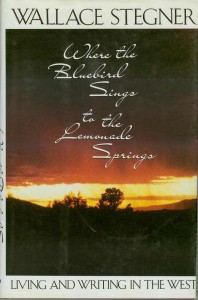Wallace Stegner’s Where the Bluebird Sings to the Lemonade Springs
A calming influence

“Forget the assignment; just go home and read Stegner.”
Liberating and comforting words from my favorite college professor, Louis Masur. I was doing a one-on-one course with him during a particularly troubled semester, and he knew just when to stray from the syllabus.
Lou and I had discovered a mutual attraction to Wallace Stegner. We were obsessed with the wavering line between fiction and nonfiction, and Stegner wrote both with equal grace and power. His voice was humble and flowing; it had just the right mixture of edgy skepticism and dogged hope. I had never felt so sustained by a writer.
I started with his novel Angle of Repose and his biography of 19th-century frontier explorer John Wesley Powell. Then, in 1992, the year I graduated, Stegner published a collection of essays that set the professional and writerly agenda for, well, the rest of my life. Built into the structure of Where the Bluebird Sings to the Lemonade Springs is the contention that all good writing is inevitably autobiographical, so you’d better get to know yourself. And your self-knowledge won’t be worth a damn without a sense of place and history.
Here I am, decades later, an environmental historian and memoirist, realizing that Stegner was offering a vision of creative nonfiction just as that genre was becoming the next big thing. Some of the essays in Bluebird seem mostly personal, and some seem mostly historical or analytical, but each of them ultimately bends its own boundaries. And each revolves around an “anguished question,” which almost always touches on our debt to those who came before.


